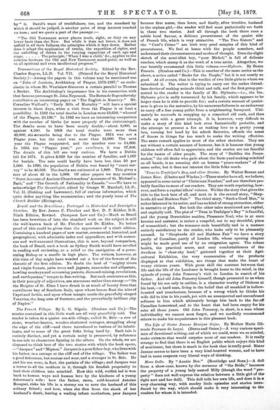The French Village. By L. G. Seguin. (Strahan and Co.)—The
stories contained in this little work are all very gracefully told. The reader is taken to a quaint sea-side village, called St. Brie—a row of stone, weather-beaten, wooden-shuttered cottages, straggling along the edge of the cliff—and there introduced to various of its inhabi- tants, and to some of the great folks living hard by. Each tale is entirely distinct, and yet a certain unity is preserved, by reference in one tale to characters figuring in the others. On the whole, we are disposed to think best of the two stories with which the book opens, —"Jacques" and "Mignon." Jacques is a poorfisher-boy, who lives with his father, in a cottage at the cliff end of the village. The father was a good fisherman, but morose and sour, and a stranger in St. Brie. He and his son were, in fact, the pariahs of the village ; and Jacques was a terror to all the mothers in it, through his fiendish propensity to lead their children into mischief. How this wild, wolfish lad is won back to human ways and human love by the kindness of a young fisherman's wife : how the father, stern, cold-hearted Antoine Bouquet, risks his life in a stormy sea to save the husband of this solitary friend ; and how, when she dies from the shock of her husband's death, leaving a walling infant motherless, poor Jacques became first nurse, then lover, and finally, after troubles, husband to the orphan girl,—the reader will find most pathetically set forth in these two stories. And all through the book there runs a subtle local flavour, a delicate presentment of the quaint side of French life, which is very attractive. " The Two Sisters" and the "Cure's Crime" are both very good samples of this kind of presentment. We feel at home with the people somehow, and understand their circumstances and modes of thought. Even the slight- sketch of the semi-idiot boy, "poor Michel," is full of delicate touches, which stamp it as the work of a tree artist. Altogether, we can heartily recommend this little volume.—Slyboots. By Beata Francis. (Strahan and Co.)—This is another of the same series as the above, a series called "Books for the People," but it is not nearly so good. At all events, that is the verdict of two little girls to whom we submitted it. The writer is trying to carry out the rather thread- bare device of making animals think and talk, and the first group pre- sented to the reader is the family of Mr. Slyboots,—i.e., the fox. Slyboots pare is sadly tormented by his family, which appears to be larger than he is able to provide for ; and a certain amount of quaint- ness is given to the narrative, by his numeronsfailures in an endeavour to carry off a fine young pullet from a neighbouring farmyard. Ulti- mately he succeeds in snapping up a conceited old cock, and then winds up with a great triumph. It is, however, very difficult to make a story of this kind look even fantastically probable, and the attempt to present a fox as making love to a pretty young hen, turning her head by his adroit flatteries, offends the sense of fitness in things far too much to make the writing effective. The same remark applies to most of the other sketches. They are not without a certain amount of humour, but it is humour that young children will often fail to appreciate, and the stories are too fanciful for the tastes of older people. The story of " Daddies the Peace• maker," the old drake who gads about the farm-yard making mischief on all hands, is an amusing skit on human " peace-makers " of the same order, but it does not interest the little folks much.


































 Previous page
Previous page